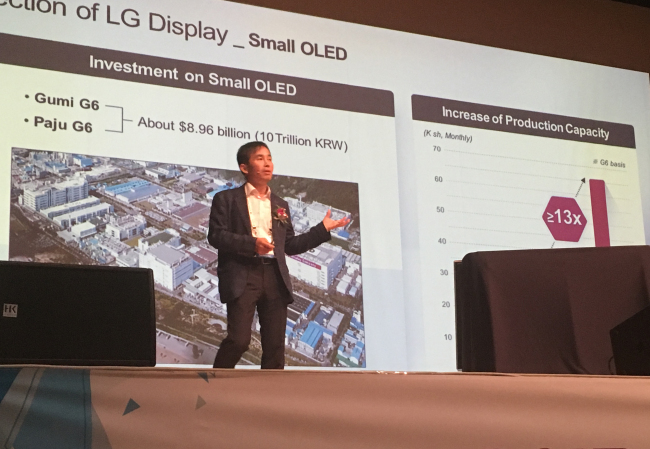[Herald Interview] ‘Smartphone OLED will face oversupply by 2020’
Display tech chief says post-OLED will still be OLED, integrated with IoT, AI and new functions
By Shin Ji-hyePublished : Aug. 30, 2017 - 16:03
Organic light emitting diodes, undoubtedly the most sought-after display right now, will face oversupply by 2020 and only innovative technologies will survive, said LG Display’s chief technology officer in a display conference in Korea.
“The world’s OLED supply for smartphones will outstrip demand by 2020, resulting in a ‘game of chicken’ among display firms. Despite that, innovative OLED technologies will still survive,” said Kang In-byeong, LG Display’s chief technology officer during his keynote speech at the International Meeting on Information Display conference held in Busan on Tuesday.
He predicted that OLED supply will grow to 25.2 million square meters by 2020 to outstrip demand of 7.3 million square meters.
The global OLED market is currently dominated by Korean display makers, Samsung and LG, in small and large panels respectively. But, Chinese firms have recently joined the race due to its flexible nature which is attracting many handset makers, including Apple.
“The world’s OLED supply for smartphones will outstrip demand by 2020, resulting in a ‘game of chicken’ among display firms. Despite that, innovative OLED technologies will still survive,” said Kang In-byeong, LG Display’s chief technology officer during his keynote speech at the International Meeting on Information Display conference held in Busan on Tuesday.
He predicted that OLED supply will grow to 25.2 million square meters by 2020 to outstrip demand of 7.3 million square meters.
The global OLED market is currently dominated by Korean display makers, Samsung and LG, in small and large panels respectively. But, Chinese firms have recently joined the race due to its flexible nature which is attracting many handset makers, including Apple.

Chinese display firms, including BOE, Visionox, EverDisplay Optronics, Truly, AOU and Tianma, all plan to expand OLED fabrications in the coming years.
“The global OLED market will see a paradigm shift in five years in terms of dominance due to the heavy investment from China,” Kang told The Korea Herald at the conference after the keynote speech.
However, the Chinese upstarts are not a threatening issue because innovative technologies will still survive in the oversupply of OLED panels, he said.
“OLED, whose technology level is still at a nascent stage, has high potential growth in terms of design flexibility and expandability,” the chief technology officer said.
With its flexible nature, OLED will be used in diverse areas by integrating with new technologies such as Internet of Things, big data, artificial intelligence and robots beyond current digital devices like smartphones and TVs.
As for its expandability, OLED will itself evolve into having multi-functions such as making sound, being used as a mirror and becoming transparent in the future. With these functions, they will replace traditional televisions, mirror and window.
“I am asked by many about post-OLED. I can’t think of any other candidate for now so I say post-OLED is still OLED,” the executive said.
“The OLED still has a long way to go because of its unexplored nature. For instance, it may take more than 20 years to see rollable and flexible OLED display perfectly fit into future connected and artificial-intelligence-powered devices,” he said.
The portion of LG Display’s OLED production is slated to grow to 40 percent in 2020 from 5 percent last year while its LCD production will drop from 95 percent to 60 percent during the same period.
By Shin Ji-hye (shinjh@heraldcorp.com)












![[Today’s K-pop] BTS pop-up event to come to Seoul](http://res.heraldm.com/phpwas/restmb_idxmake.php?idx=644&simg=/content/image/2024/04/17/20240417050734_0.jpg&u=)





![[KH Explains] Hyundai's full hybrid edge to pay off amid slow transition to pure EVs](http://res.heraldm.com/phpwas/restmb_idxmake.php?idx=652&simg=/content/image/2024/04/18/20240418050645_0.jpg&u=20240419100350)

![[Today’s K-pop] Zico drops snippet of collaboration with Jennie](http://res.heraldm.com/phpwas/restmb_idxmake.php?idx=642&simg=/content/image/2024/04/18/20240418050702_0.jpg&u=)